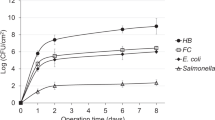Abstract
The populations of Pseudomonas sp. B4, Escherichia coli, Klebsiella pneumoniae, Micrococcus flavus, and Rhizobium leguminosarum biovar phaseoli declined rapidly in lake water. The initially rapid decline of the two pseudomonads and R. phaseoli was followed by a period of slow loss of viability, but viable cells of the other species were not found after 10 days. The rapid initial phase of decline was not a result of Bdellovibrio spp., bacteriophages, or toxins in the water since Bdellovibrio spp. were not present and passage of the lake water through filters that should not have removed bacteriophages or soluble toxins led to the elimination of the rapid phase of decline. The addition of 250 μg of cycloheximide and 30 μg of nystatin per ml eliminated viable protozoa form the lake water, and the population of Pseudomonas sp. B4 did not fall and the decline of E. coli and K. pneumoniae was delayed or slowed under these conditions. Pseudomonas sp. L2 proliferated rapidly in lake water amended with glucose, phosphate, and NH4NO3, but its numbers subsequently fell abruptly; however, in water amended with cycloheximide and nystatin, which killed indigenous protozoa, the population density was higher and the fall in numbers was delayed. Of the nutrients, the chief response was to carbon, but when glucose was added, phosphorus and nitrogen stimulated growth further. Removing other bacteria by filtering the lake water before inoculation with Pseudomonas sp. L2 suggested that competition reduced the extent of response of the pseudomonad to added nutrients. We suggest that the decline in lake water of bacteria that are resistant to starvation may be a result of protozoan grazing and that the extent of growth of introduced species may be limited by the supply of available carbon and sometimes of nitrogen and phosphorus, and by predation by indigenous protozoa.
Similar content being viewed by others
References
Alexander M (1981) Why microbial predators and parasites do not eliminate their prey and hosts. Annu Rev Microbiol 35:113–133
Alexander M (1986) Survival and growth of bacteria. Environ Manag 10:464–469
Chamberlin CE, Mitchell R (1978) A decay model for enteric bacteria in natural waters. In: Mitchell R (ed) Water pollution microbiology, vol 2. John Wiley, New York, pp 325–348
Enzinger RM, Cooper RC (1976) Role of bacteria and protozoa in the removal of Escherichia coli from estuarine waters. Appl Environ Microbiol 31:758–763
Findlay S, Carlough L, Crocker MT, Gill HK, Meyer JL, Smith PH (1986) Bacterial growth on macrophyte leachate and fate of bacterial production. Limnol Oceanogr 31:1335–1341
Hoben HJ, Somasegaran P (1982) Comparison of the pour, spread, and drop plate methods for enumeration of Rhizobium spp. in inoculants made from presterilized peat. Appl Environ Microbiol 44:1246–1247
Klein TM, Alexander M (1986) Bacterial inhibitors in lake water. Appl Environ Microbiol 52:114–118
Lessard EJ, Sieburth JMcN (1983) Survival of natural sewage populations of enteric bacteria in diffusion and batch chambers in the marine environment. Appl Environ Microbiol 45:950–959
Liang LN, Sinclair JL, Mallory LM, Alexander M (1982) Fate in model ecosystems of microbial species of potential use in genetic engineering. Appl Environ Microbiol 44:708–714
Mallory LM, Yuk CS, Liang LN, Alexander M (1983) Alternative prey: a mechanism for elimination of bacterial species by protozoa. Appl Environ Microbiol 46:1073–1079
McCambridge J, McMeekin TA (1980) Relative effects of bacterial and protozoan predators on survival of Escherichia coli in estuarine water samples. Appl Environ Microbiol 40:907–911
McFeters GA, Stuart DG (1972) Survival of coliform bacteria in natural waters: fieled and laboratory studies with membrane-filter chambers. Appl Microbiol 24:805–811
Novitsky JA, Morita RY (1977) Survival of a psychrophilic marine vibrio under long-term nutrient starvation. Appl Environ Microbiol 33:635–641
Rassoulzadegan F, Sheldon RW (1986) Predator-prey interactions of nanozooplankton and bacteria in an oligotrophic marine environment. Limnol Oceanogr 31:1010–1021
Riemann B (1985) Potential importance of fish predation and zooplankton grazing on natural populations of freshwater bacteria. Appl Environ Microbiol 50:187–193
Sanders RW, Porter KG (1986) Use of metabolic inhibitors to estimate protozooplankton grazing and bacterial production in a monomictic eutrophic lake with an anaerobic hypolimnion. Appl Environ Microbiol 52:101–107
Sherr EB, Sherr BF (1987) High rates of consumption of bacteria by pelagic ciliates. Nature (Lond) 325:710–711
Sinclair JL, Alexander M (1984) Role of resistance to starvation in bacterial survival in sewage and lake water. Appl Environ Microbiol 48:410–415
Tremaine SC, Mills AL (1987) Inadequacy of the eucaryote inhibitor cycloheximide in studies of protozoan grazing on bacteria at the fresh-water-sediment interface. Appl Environ Microbiol 53:1969–1972
Author information
Authors and Affiliations
Rights and permissions
About this article
Cite this article
Scheuerman, P.R., Schmidt, J.P. & Alexander, M. Factors affecting the survival and growth of bacteria introduced into lake water. Arch. Microbiol. 150, 320–325 (1988). https://doi.org/10.1007/BF00408301
Received:
Accepted:
Issue Date:
DOI: https://doi.org/10.1007/BF00408301




